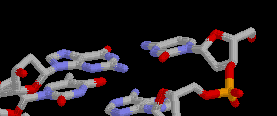
There is no time limit on this test, though I have tried to design one that you should be able to complete within 2.5 hours, except for typing. You are not allowed to use your notes, or any books, nor are you allowed to discuss the test with anyone until Wednesday Feb. 3, 1999. EXAMS ARE DUE AT 10:30 ON WEDNESDAY, FEBRUARY 3. You may use a calculator and/or ruler. The answers to the questions must be typed on a separate sheet of paper unless the question specifically says to write the answer in the space provided. If you do not write your answers on the appropriate pages, I may not find them unless you have indicated where the answers are.
Please do not write or type your name on any page other than this cover page. Staple all your pages (INCLUDING THE TEST PAGES) together when finished with the exam.
Name (please print here):
Write out the full pledge and sign:
How long did this exam take you to complete (excluding typing)?
6 pts.
1. You have been asked by Kenneth Starr (no relation to Ringo) to identify this molecule. Of course you recognize it to be a piece of double stranded DNA and you even notice that the bases shown probably have 3 H-bonds between them.
a. After stating your name for the record, tell the grand jury which base appears on the left and which one on the right (typical partisan politics).
b. As if this were not enough, now the "special prosecutor" wants to know which base is on the 5' end and which one is on the 3' end of each strand. Please tell him the correct answer or you will be prosecuted.

6 pts.
2. DNA replication can be a political hot potato(e). But there are some very useful enzymes for us to use. Tell me which enzyme we have used in lab and why we used it.
16 pts.
3. The following notes were found in the kitchen of a work study student and a certain teacher has been accused of leaking classified information tostudents who wanted to take his class but were obstructed from doing so. Please help clarify the situation by showing that this course is not so hard and telling the congress how to do these calculations:
a. Make a 500 mL solution that is 5 mM NaCl, 15% SDS (v/v if the stock solution of SDS is 50% w/v), 0.01 M Tris-HCl, pH 7.5. (FW NaCl = 58.44; FW Tris = 121; FW SDS = 288.4)
b. How many microliters (µL) would you need to pipet if you wanted to deliver 750 ng of a dsDNA to a new tube? The OD260 of the solution you are to pipet read 0.084. (Remember the formula for conversion: 1 OD 260 unit has a concentration of 50 µg/mL dsDNA.)
c. What does OD 260 mean anyway??
d. Make a 150 mL solution that is 1200 µM NaCl, and 0.05 mM KOH (stock solution of KOH is 5 M ), and 0.1 M SDS (start with the dry stuff).
18 pts.
4. Using the DNA sequencing gel below, please help us identify the owner of this DNA. The dideoxynucleotides that were used were loaded in the order of (left to right) C G A T.
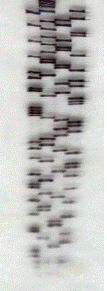
a. Record for the senate the sequence of this DNA (not the template DNA) from 5' to 3'. You should be able to read at least 45 bases. Please record the first 45 you can read.
b. Look for the first start codon and translate as much as you can using the codon table below. You must use the full names of the amino acids.
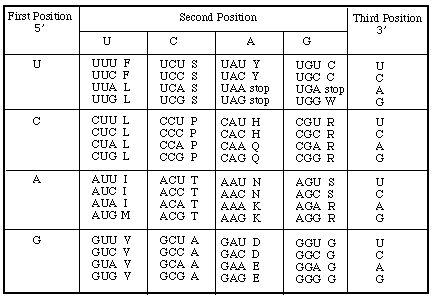
6 pts.
5. If this piece of DNA were a cDNA, explain to those non-science members of the House what is 5' to a start codon and downstream of a stop codon. Also explain the function of these features.
6 pts.
6. The House managers have determined that a certain protein has been identified that was not where it should be. They claim it should have been in the cytoplasm but was instead found located in the Golgi body! (Gasp!) Explain to this one-minded group what one would have to do to the gene of a person to convert a Golgi-localized protein into a cytoplasmic protein.
6 pts.
7. Tell me how you would clone the ampicillin resistance gene from plasmid A into plasmid B (both of which are popular plasmids in political circles, and completely sequenced) at the Kpn site indicated by an arrow. To receive full credit, you must tell me how you would know your cloning attempt was successful or not. pA is 3.6 kb and pB is 3.0 kb in size.
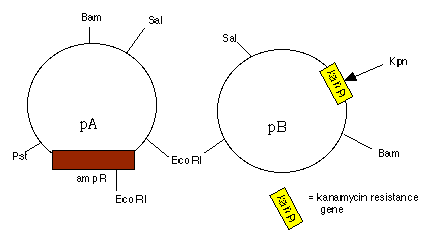
8 pts.
8. Let's make up a completely fictitious situation. Let's say a very famous person was involved in a sexual affair with someone half his (or her) age and knew it was wrong. But the younger adult wanted to take advantage of the situation and saved some evidence of the affair for later use. How would this younger person prove that she (or he) possessed a piece of clothing that was stained by the older adult? (Does everyone understand the scenario here? If not, call me to clarify what we are talking about.)
a. What method would you recommend that the younger one (she or he) use and why?
b. What controls would be necessary when performing your recommended experiment?
14 pts.
9. Let's imagine there is a genetic disease that forces a person to do dumb things every 4 months. And let's imagine that this gene is expressed in the big toe. Let's also imagine that people afflicted with this disease have very large big toes and the dumb-gene protein is easily purified. The next three questions do not have to have related answers so don't let "a" stop you from being creative with "b" or "c", for example.
a. Explain to me how you would go about deducing the amino acid sequence of this dumb protein in the fastest way possible (your country's next official dumb act is only a couple days away). This gene has never been cloned before in any species.
b. How would you determine what tissues, if any, the mouse homologous protein is expressed in mice?
c. How would you design a plasmid that would act as an early warning system in humans when this gene is getting ready to be transcribed again so you could prevent the next outbreak of dumbness in humans with said disease?
4 pts.
10. For the molecule depicted, tell me which amino acid substitution (multiple choice from below) might cause the greatest functional change and why you think so.
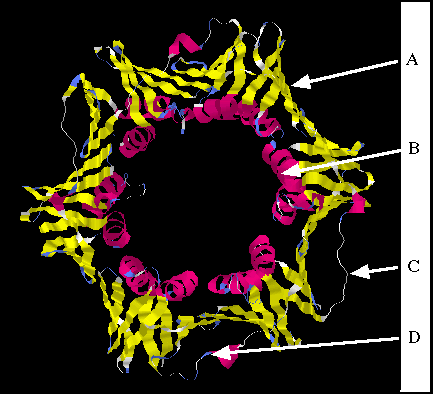
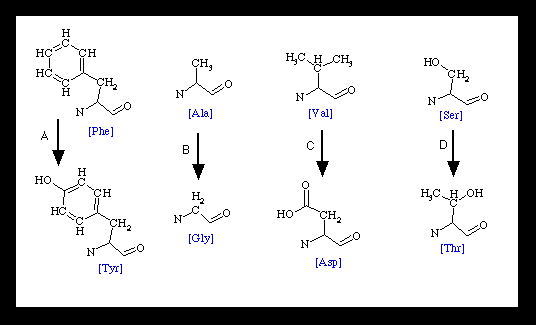
10 pts.
11. Tell me how you could make a monoclonal antibody against the mouse act-dumb protein and then find out if it bound to the human homolog or not.
© Copyright
2000 Department of Biology, Davidson College, Davidson, NC 28036
Send comments, questions, and suggestions to: macampbell@davidson.edu